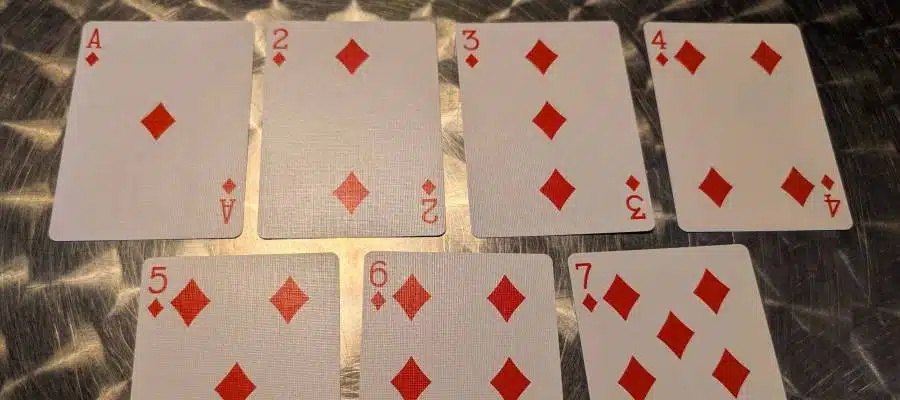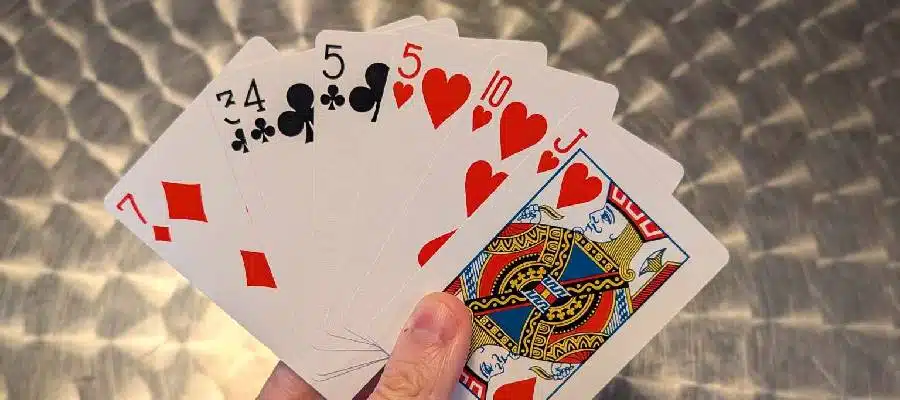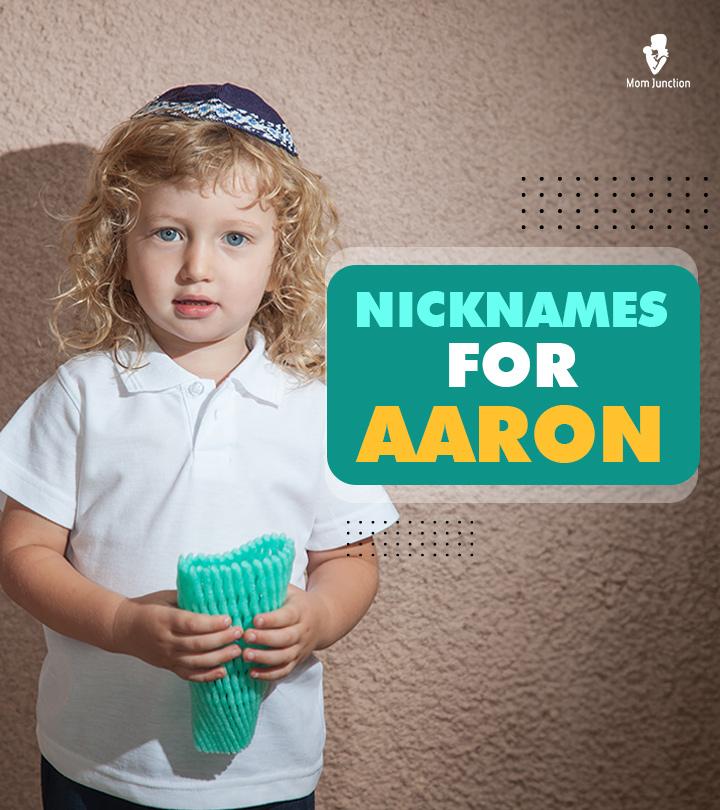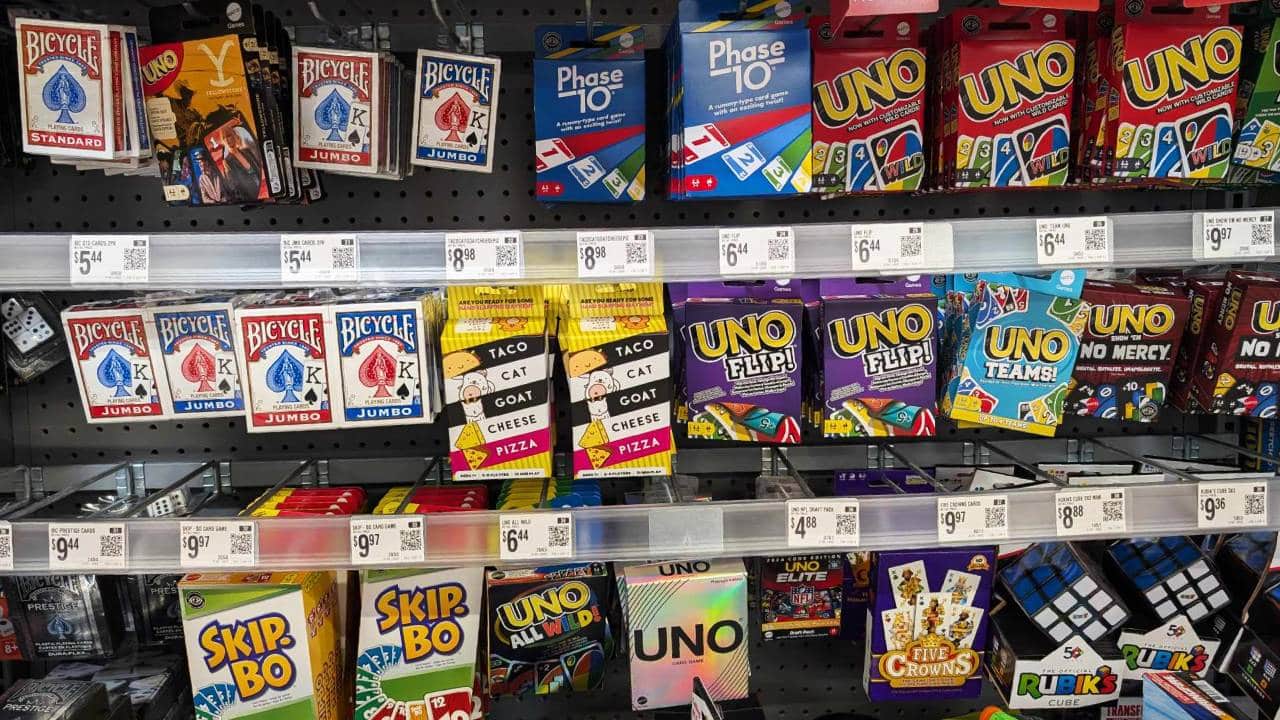January 2, 2025
Family card games are a fantastic way for everyone to spend time together and have fun. They encourage friendly competition, build communication skills, and strengthen family bonds. Playing these games also helps children practice important skills like quick thinking and simple math, while adults enjoy a chance to unwind and laugh with loved ones. Card games are great for the family because they’re very quick to learn and easy to travel with. Whether you’re at home, on a road trip, or at an airport, you can have great family fun with just a deck of cards.
Best Family Card Games
The following games can all be played with just a normal deck of cards! Chances are, you have a deck of cards at home already, so these games are free family fun. Make your family game night more fun with the following card games:

1. Go Fish
Go Fish involves asking one another for specific cards and drawing if you don’t get what you need, creating suspense as each player strives to make complete sets. The gentle pace and simple rules let kids practice important social skills like turn-taking and polite interaction. Older players can find fun in the occasional lucky draw that finishes off a four-of-a-kind.
How to Play:
- Deal 5–7 cards (depending on the number of players).
- On your turn, you ask another player for a specific rank card (e.g., “Do you have any 3s?”).
- If that player has it, they must give you all cards of that rank. If they don’t, they say “Go Fish,” and you draw from the deck.
- Whenever you collect 4 of a kind (like four 7s), you set that collection aside.
- The game ends when the deck is exhausted or when one player runs out of cards. The player with the most completed sets wins.
2. Old Maid
Old Maid blends tension and humor as everyone frantically discards pairs while avoiding one pesky, unmatched card. The game keeps everyone guessing over who’s stuck holding the “Old Maid.” It’s a great card game that helps kids learn to keep track of their cards while enjoying the silliness of trying to dodge that one unwelcome queen.
How to Play:
- Remove one queen from the deck to be the “Old Maid.”
- Deal all the cards evenly.
- Players sort their cards, discarding any pairs (two of the same rank) they can make.
- Take turns offering your hand to the player on your left; they randomly pull one card.
- Each time you form a pair, you discard it. The game continues until only the Old Maid remains.
- The player holding the Old Maid at the end loses.
3. Crazy Eights
Crazy Eights stirs up an energetic card table by challenging each player to match the top discard in either suit or rank—only to throw in a twist: any 8 in your hand can instantly shift the suit to your advantage. This leads to sudden reversals and plenty of laughter, whether you’re playing with just one partner or a small group. Quick thinking and adaptability are key to victory in this card game.
How to Play:
- Deal 5 cards to each player (7 for just 2 players).
- Turn the top card of the remaining deck face up to form the discard pile.
- On your turn, play a card from your hand that matches the top discard by rank or suit.
- Eights (8s) are wild and can be played at any time, allowing you to change the suit.
- If you cannot play, you must draw cards from the deck until you can.
- First player to empty their hand wins.
4. Blackjack (Classic 21)
Blackjack is one of the most widely played casino card games, where players try to get a hand total closer to 21 than the dealer without going over. With strategic decisions like hitting, standing, doubling down, or splitting, players balance risk and reward in each round, adding an element of excitement that draws enthusiasts worldwide. It can be a fun family card game by using imaginary chips instead of real money.
How to Play:
- One person serves as the dealer. Each player places a small “bet” (e.g., chips, tokens).
- Deal two cards face up to each player and two to the dealer (one face up, one face down).
- Players take turns “hitting” (receiving another card) or “standing” (staying with their total) to get as close to 21 as possible.
- Face cards count as 10, Aces can be 1 or 11, and all others count as face value.
- After all players finish, the dealer reveals their face-down card and hits until reaching 17 or higher (or busts).
- Anyone closer to 21 than the dealer (without going over) wins; going over 21 is an automatic loss (bust).
5. Spoons
Spoons is a lively, fast-paced card game that requires both speed and quick observation. Players race to collect four of a kind and snatch a spoon from the center, all while trying not to be the last person left empty-handed. Spoons is one of those card games that is a classic at sleepover parties!
How to Play:
- Gather a spoon for each player minus one (e.g., if 5 people are playing, use 4 spoons).
- Deal 4 cards to each player.
- Players simultaneously pass one unwanted card from their hand to the left. They aim to collect 4 of a kind.
- Once a player gets 4 of a kind, they quietly (or not so quietly!) grab a spoon from the center of the table.
- Once the first spoon is taken, everyone else must grab a spoon as fast as possible. The person left without a spoon is out.
- Continue until one person remains.
6. Slapjack
Slapjack is a card game that tests players’ reflexes and attention. As each card is flipped, everyone rushes to slap the pile when a jack appears, making for sudden bursts of excitement and frantic competition.
How to Play:
- Deal all cards evenly among players, face down.
- Players take turns flipping the top card from their pile onto a center pile.
- Whenever a jack appears, the first player to “slap” the pile wins that pile and adds those cards to their deck.
- If you run out of cards, you’re out (though some variations let you keep slapping to get back in).
- Last player holding cards is the winner.
7. War
War is a simple, straightforward card game in which two players simultaneously reveal the top card from their decks. The player with the higher card takes both, but in the event of a tie, a mini “war” breaks out, adding an extra dose of suspense and anticipation.
How to Play:
- Deal the entire deck evenly between two players, face down.
- Each player flips the top card of their pile at the same time. The higher card wins both cards and places them at the bottom of their deck.
- If there’s a tie (same rank), each player places three cards face down and flips the next card (the “war”). The higher card wins all the cards.
- Continue until one player collects all cards.
8. Memory (Concentration)
Memory (sometimes called Concentration) transforms a deck of cards into a brain-teasing challenge that works beautifully with just one child practicing alone or a small crowd gathered around the table. By flipping and matching pairs, everyone exercises their focus and recall in a calm yet surprisingly competitive atmosphere. Kids gain confidence each time they remember exactly where that tricky pair was hiding, while parents and grandparents can’t help but get drawn in by the game’s steady, satisfying rhythm.
How to Play:
- Spread all cards face down in rows.
- On your turn, flip over two cards: if they match in rank, you keep them and take another turn. If they don’t match, flip them back over.
- Play continues to the next person.
- The player with the most matched pairs at the end wins.
(Tip: For younger players, remove some of the more complex cards to reduce the size of the layout.)
9. Rummy
Rummy is a classic card-matching game where players aim to form “melds” of cards. This means putting together sets of the same value or runs of sequential cards in the same suit. Strategy comes into play as each player decides which cards to keep, draw, or discard, all while trying to go out first.
How to Play:
- Deal 7 cards to each player.
- The top card of the deck is flipped to start the discard pile.
- On your turn, draw either from the deck or from the top card of the discard pile.
- Try to form sets (e.g., three 6s) or runs (e.g., 4–5–6 of hearts).
- Discard one card at the end of your turn.
- When one player lays down all (or most of) their cards in valid sets/runs and discards, the round ends. Scores are tallied based on leftover cards. Low score wins after several rounds.
10. Snap
Snap is a quick and entertaining card game that hinges on players’ sharp observation and fast reflexes. As each player flips a card onto a communal pile, everyone must watch for a matching pair and shout “Snap!” first to win the pile. Since the game is so quick, it is great for playing multiple rounds!
How to Play:
- Deal all cards face down to each player, forming individual piles.
- Players flip their top card onto a central pile (or their own small discard pile) in turn.
- If two consecutive face-up cards match in rank, the first player to shout “Snap!” gets both piles.
- Last player with cards is the winner.
11. BS (aka “Cheat” or “I Doubt It”)
BS, also known as Cheat or I Doubt It, is a card game where players try to get rid of all their cards by discarding them face down and declaring what they’ve played. Other players can call “BS!” if they think someone is bluffing, creating dramatic reveals and plenty of strategic, sneaky fun.

How to Play:
- Deal all the cards as evenly as possible among the group.
- Starting with Ace, each player places one or more face-down cards and declares them (e.g., “One Ace”).
- If another player suspects lying, they can say “BS!” (or “I doubt it!”).
- Reveal the cards: if the challenger is correct, the bluffer takes the entire center pile into their hand; if the challenger is wrong, they take the pile instead.
- Ranks progress from A → 2 → 3 and so on, cycling back to Ace after King.
- First player to discard all cards wins.
12. Kings in the Corner
Kings in the Corner is a solitaire-style card game that can be played by two to four players which makes it a great game for family game night! Players place cards in descending order and opposite color suits, using the corners for kings to open up additional piles, all while racing to be the first to get rid of their entire hand.
How to Play:
- Deal 7 cards to each player; place the remaining deck in the center as a draw pile.
- Flip 4 cards face up around the draw pile (top, bottom, left, right) to start foundation piles.
- Aces are low; place cards in descending order and alternating color on foundation piles (e.g., red 10 on black Jack).
- Kings start new piles in the “corners.”
- On your turn, draw a card, then play any cards you can to the piles. Move entire sequences if space allows.
- Discard as many cards as possible to the foundations; first player to empty their hand scores points (low score wins after multiple rounds).
13. Egyptian Rat Screw
Egyptian Rat Screw is a fast-paced card game that tests both reflexes and luck. Players take turns flipping cards into a central pile, racing to slap it when specific combos—like pairs or sandwiches—show up, leading to quick-thinking excitement and plenty of laughter.
How to Play:
- Deal the deck evenly among players, face down.
- In turn, flip the top card onto a center pile.
- Anyone can slap the pile when they see specific patterns (commonly pairs, sandwiches, or runs).
- Whoever slaps first correctly collects all those center cards.
- If a player runs out of cards, they can still try to slap back in if a valid pattern appears.
- The game ends when one player has all the cards.
14. Spit (aka Speed)
Spit is a lightning-fast, two-player card game in which participants race to get rid of their decks by rapidly laying cards onto central piles. Quick reflexes and sharp observation are essential, as both players simultaneously look for valid moves, creating an intense, head-to-head showdown.
How to Play:
- Shuffle and deal the deck evenly between two players, each making piles facedown (the standard is five piles each in a specific formation).
- Each person turns over the top card of two “spit piles” in the middle.
- Simultaneously (no turns), both players place cards from their face-up piles onto the spit piles, following ascending or descending order.
- If no moves are possible, each player flips a new “spit” card into each pile.
- Continue until one player empties their piles and slaps the smaller center pile to win.
- The game can be played in multiple rounds, with the winner being whoever gets rid of all their cards first.
15. Garbage (aka Trash)
Garbage, also known as Trash, is a simple card game.. Each player aims to fill a sequence of facedown spots (often ten), turning over and placing drawn cards in their correct positions, with the goal of completing the layout first.
How to Play:
- Deal 10 cards facedown to each person in a row; remaining cards form a draw pile.
- Each slot in front of you is numbered 1–10 from left to right.
- Flip the top card of the draw pile: if it’s a 1–10, place it in the matching slot; if it’s a face card (Jack/Queen/King), discard it or use house rules (e.g., Jack is wild).
- Reveal the card in the slot you just filled, and continue placing or discarding until you can’t play.
- If you place a card in the 10th slot correctly, draw again.
- First player to fill all slots in order (1–10) wins that round; reduce the row by one card for each subsequent round until someone completes the final round.
16. Pig
Pig is a lively card game where players race to collect four of a kind, then subtly signal their success—often by touching their nose—to avoid detection. Everyone else must copy the signal before the last person catches on, making for hilarious moments as players scramble to avoid being labeled the “Pig.”
How to Play:
- Sit in a circle and deal 4 cards to each player.
- Each player simultaneously chooses one card to pass to the left, aiming to collect 4 of a kind.
- When anyone completes 4 of a kind, they discreetly touch their nose (or perform another agreed-upon signal).
- One by one, other players catch on and do the same until one person is left out—this player is “the pig”!
- Shuffle up and start another round as desired.
17. Golf (9-Card or 6-Card Variation)
Golf is a laid-back game that involves minimizing your score by carefully swapping out hidden cards for better ones. Played in several common variations (like 4-Card, 6-Card, or 9-Card), it keeps everyone engaged as they decide which unknown cards to keep and which to discard. The suspense of flipping a mystery card and the triumph of uncovering a surprise low value make Golf a family favorite that balances luck and light strategy.
How to Play:
- Each player is dealt a grid of face-down cards (commonly 6 or 9 cards).
- Reveal two of your cards to start; the remaining cards stay face down.
- On your turn, draw from the deck or discard pile. You may swap the drawn card with one of your face-down cards, then flip up that replaced card.
- Card values typically match their rank (A=1, J/Q/K=10), but check house rules for variations.
- Once all of one player’s cards are face up, each other player takes one more turn.
- Tally scores (sum of all card values); after multiple rounds, low total wins.
18. 31
31 is a fast, easy-to-learn card game in which each player tries to collect a hand that sums to as close to 31 as possible in a single suit. Players draw and discard in turn, and whoever knocks first after reaching a high total sets off a final round, with the highest scoring hand winning.
How to Play:
- Deal 3 cards to each player; put the rest of the deck in the center as a draw pile.
- On your turn, draw one card and discard one card.
- Card values: A=1 or 11 (house rules vary), face cards=10, others=face value.
- Aim for the highest total in one suit—31 is best.
- If you believe you have a strong hand, you can “knock.” Everyone gets one last turn, then reveals hands.
- Lowest total loses a life token; the game continues until only one player remains.
19. Palace (aka “Shithead” or “Karma”)
Palace weaves together a bit of hand management, strategic trick-taking, and plenty of surprises as you race not to be the last one holding cards. Each player keeps some hidden cards to flip in the final phase, adding excitement as powerful moves can come from nowhere. The combination of placing cards in ascending order, clearing stacks with special plays, and flipping hidden cards at the end ensures every round is unpredictable and engaging.
How to Play:
- Deal each player 3 face-down “palace” cards (not viewed yet), 3 face-up cards on top of those, and a hand of 3 more cards.
- Play proceeds clockwise, placing cards on a central pile in ascending order (or equal to the top card).
- Certain cards (like 2 or 10) have special effects—2 resets the pile, 10 clears it, etc. (Exact “specials” vary by house rules.)
- If you can’t play, pick up the entire pile.
- Once your hand is empty, start using your face-up cards, and after those are gone, flip and play your palace cards one by one.
- Last player left with cards loses; first one to finish is often deemed the winner.
Specialty Family Card Games
The following card games don’t use a standard deck of cards. You will have to purchase the games. Fortunately, the cards are relatively inexpensive and still really easy to travel with.
20. Uno
Uno is a fast-paced, family-friendly card game where players race to get rid of all their cards first. It’s known for its colorful design, wild cards, and unpredictable reversals of fortune that keep everyone on their toes until the very last play. Just remember to yell “uno” when you only have one card left!!
How to Play (Uno deck required):
- Each player starts with 7 cards.
- Match the top card of the discard pile by color, number, or symbol.
- Special cards (Skip, Reverse, Draw Two, Wild, and Wild Draw Four) add extra twists.
- If you cannot play a matching card, you must draw from the draw pile.
- First player to have no cards left wins (and remember to call out “Uno” when you have only one card left).
21. Dutch Blitz
Dutch Blitz energizes the table with its fast-paced, simultaneous card-flipping action, where everyone races to empty their “blitz” pile first. Each player works on community foundation piles in ascending order, often swatting cards down at the same time and cheering or groaning as they jockey for a spot. The frenzied nature rewards sharp reflexes, quick mental math, and a dash of luck, making it an absolute hit with competitive families.
How to Play (requires Dutch Blitz deck):
- Each player has a 10-card “blitz” pile, three “post” piles (cards face up), and the rest as a “wood” pile to cycle through.
- Everyone flips cards and plays simultaneously, building on central foundation piles in ascending order (1 to 10, matching colors/suits as per the deck’s design).
- If you can’t play from your post piles, flip from the top of your wood pile in sets of three (similar to solitaire).
- Continue shifting cards onto the foundation piles or from your blitz pile to your post piles whenever possible.
- The first person to clear their blitz pile calls “Blitz!”—scores are tallied, and the highest total after several rounds wins.
22. Taco Cat Goat Cheese Pizza
Taco Cat Goat Cheese Pizza whips up a riot of laughter by asking everyone to chant these five words in sequence while flipping a card, ready to slap the pile when a word and card picture match. The tension builds as players try to maintain the rhythm, inevitably slipping up and either slapping too soon or missing a match. Its frantic tempo and silly theme make it perfect for short, high-energy bursts of fun with the whole family.
How to Play (requires Taco Cat Goat Cheese Pizza deck):
- Shuffle and deal the entire deck face down among all players.
- In turn, each person places a card face up in the center and says the next word in the “Taco Cat Goat Cheese Pizza” sequence (cycling back to “Taco” after “Pizza”).
- If the word spoken matches the image on the card, everyone slaps the center pile; the last person to slap (or someone who slaps incorrectly) must take the pile.
- Continue until one player gets rid of all their cards, then survives one extra round without having to pick up the pile.
- That person is the winner—get ready for lots of mix-ups, laughter, and lightning-fast reflexes.
23. Skyjo
Skyjo captivates players with its blend of set collection and risk-taking as you flip, swap, and carefully arrange a grid of numerical cards. It involves the perfect balance of strategy and luck. It is also great for learning addition and subtraction!
How to Play (requires Skyjo deck):
- Deal each player 12 cards face down in a 3×4 grid. Reveal two of your cards to start.
- On your turn, draw a card from either the deck or the discard pile.
- You may swap the drawn card with one of your face-down cards, which gets flipped and placed onto the discard pile.
- Your goal is to keep your total score as low as possible, discarding high-value cards whenever you can.
- Rounds end when someone flips all their cards face up; each player then tallies their numbers, and you carry your cumulative score into further rounds.
- After multiple rounds, the lowest overall score wins.
24. Skip-Bo
Skip-Bo takes elements of solitaire and builds them into an engaging multiplayer race, where you strive to empty your stockpile by creating sequential stacks in the center. The deck’s special “Skip-Bo” wild cards let you jump over missing numbers or extend runs, sparking plenty of creative plays. With its clear goal—be the first to discard all your stockpile cards—it’s easy for kids and adults to learn and keeps everyone glued to the table.
How to Play (requires Skip-Bo deck):
- Shuffle and deal each player a stockpile of cards (e.g., 30 cards for 2–4 players), face down.
- Flip the top card of your stockpile and keep a hand of five cards.
- Play cards onto any of up to four shared building piles in ascending numerical order (1 through 12). Skip-Bo cards act as wilds.
- If you can’t make more plays, discard one card onto your personal discard pile (you can have up to four).
- Draw back to five cards at the end of your turn.
- Continue until someone empties their entire stockpile; that person is the winner.
25. Monopoly Deal
Monopoly Deal is a fast-paced card game that retains the charm of the classic Monopoly board game but plays in a fraction of the time. Players collect property sets, charge each other rent, and cleverly use action cards to sabotage opponents, making each round unpredictable and exciting.
How to Play (requires Skip-Bo deck):
- Shuffle the deck thoroughly and deal five cards to each player.
- Place the remaining deck face-down in the center to form the draw pile.
- Each player arranges their play area with a Bank for money, a Property area for collected cards, and a hand to hold unplayed cards.
- On your turn, if you have fewer than five cards, draw until you have five in your hand; otherwise, do not draw.
- Play up to three cards by placing them in your Bank, laying them down as Property, or using their Action text.
- When required to pay another player, use money from your Bank first, and if that is insufficient, pay with Property cards.
- At the end of your turn, if you have more than seven cards, discard until you have only seven.
- The first player to complete three full sets of Property cards wins immediately

 PARENTING TIPS
PARENTING TIPS







 PREGNANCY
PREGNANCY








 BABY CARE
BABY CARE








 TODDLERS
TODDLERS








 TEENS
TEENS








 HEALTH CARE
HEALTH CARE








 ACTIVITIES & CRAFTS
ACTIVITIES & CRAFTS








 CONTACT
CONTACT ABOUT
ABOUT



